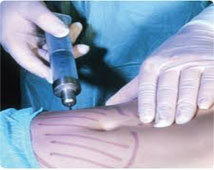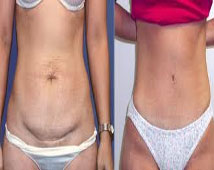Cosmetic Surgery

-
BREAST AUGMENTATION
Breast augmentation is the surgical placement of breast implants to increase fullness and projection of the breasts or to improve symmetry of the breasts. Clinically referred to as augmentation mammaplasty, the procedure is used cosmetically to:
-
Enlarge a naturally small breast, most commonly the result of heredity
Restore breast volume lost following pregnancy, as a result of breast-feeding or due to weight loss
Achieve better symmetry when breasts are moderately disproportionate in size and shape
-
Get lab testing or a medical evaluation
Take certain medications or adjust your current medications
Get a baseline mammogram before surgery and another one after surgery to help detect any future changes in your breast tissue
Stop smoking well in advance of your breast augmentation surgery
Avoid taking aspirin, anti-inflammatory drugs and herbal supplements as they can increase bleeding
Medications are administered for your comfort during breast augmentation surgery. The choices include intravenous sedation and general anesthesia. Incisions vary based on the type of implant, degree of enlargement desired, your particular anatomy, and patient-surgeon preference.
Breast size and shape are important, so be honest and open about your expectations when talking with your surgeon.
Implant type and size will be determined not just on your desired increase in size but more importantly on your breast anatomy, skin elasticity and body type.
After the incision is made, a breast implant is inserted into a pocket either:
-
Under the pectoral muscle (a submuscular placement), or
Directly behind the breast tissue, over the pectoral muscle (a submammary/ subglandular placement) -

BREAST LIFT
Breast lift, technically called mastopexy, is surgery that raises and firms the breasts by removing excess skin and tightening the surrounding tissue to reshape and support the new breast contour.
Preparation for the surgery
- Get lab testing or a medical evaluation
- Take certain medications or adjust your current medications
- Get a baseline mammogram before surgery and another one after surgery to help detect any future changes in your breast tissue
- Stop smoking well in advance of surgery
- Avoid taking aspirin, anti-inflammatory drugs and herbal supplements as they can increase bleeding
Medications are administered for your comfort during breast lift surgery. The choices include intravenous sedation and general anesthesia. Your doctor will recommend the best choice for you. After your doctor makes the incisions:
The underlying breast tissue is lifted and reshaped to improve breast contour and firmness.
- The nipple and areola are repositioned to a natural, more youthful height.
- If necessary, enlarged areolas are reduced by excising skin at the perimeter.
- Excess breast skin is removed to compensate for a loss of elasticity.
After your breasts are reshaped and excess skin is removed, the remaining skin is tightened as the incisions are closed.Some incision lines resulting from breast lifts are concealed in the natural breast contours; however, others are visible on the breast surface. Incision lines are permanent, but in most cases will fade and significantly improve over time.
Sutures are layered deep within the breast tissue to create and support the newly shaped breasts. Sutures, skin adhesives and/or surgical tape may be used to close the skin. The results of your breast lift surgery are immediately visible.
Over time, post-surgical swelling will resolve and incision lines will fade.
Satisfaction with your new image should continue to grow as you recover and realize the fulfillment of your goal for breasts which have been restored to a more youthful and uplifted position.
-

FACE LIFT
If you are bothered by signs of aging in your face, facelift surgery may be right for you. Technically known as rhytidectomy, a facelift is a surgical procedure to improve visible signs of aging in the face and neck, such as:
- Sagging in the midface
- Deep creases below the lower eyelids
- Deep creases along the nose extending to the corner of the mouth
- Fat that has fallen or is displaced
- Loss of muscle tone in the lower face may create jowls
- Loose skin and excess fatty deposits under the chin and jaw can make even a person of normal weight appear to have a double chin
Rejuvenation procedures typically performed in conjunction with a facelift are brow lift, to correct a sagging or deeply furrowed brow, and eyelid surgery to rejuvenate aging eyes.
Preparation for the surgery
- Get lab testing or a medical evaluation
- Take certain medications or adjust your current medications
- Stop smoking well in advance of surgery
- Avoid taking aspirin, anti-inflammatory drugs and herbal supplements as they can increase bleeding
Face lift surgery
Medications are administered for your comfort during a facelift procedure. The choices include intravenous sedation and general anesthesia. Your doctor will recommend the best choice for you. Depending on the degree of change you’d like to see, your rhytidectomy surgery choices include a traditional facelift, limited incision facelift or a neck lift.
Once healed, the incision lines from a facelift are well concealed within the hairline and in the natural contours of the face and ear. The visible improvements of a facelift appear as swelling and bruising subside. Your final result should not only restore a more youthful and rested appearance, but also help you feel more confident about yourself. -

LIPOSUCTION
Liposuction, also known as lipoplasty, slims and reshapes specific areas of the body by removing excess fat deposits, improving your body contours and proportion, and ultimately, enhancing your self-image. Despite good health and a reasonable level of fitness, some people may still have a body with disproportionate contours due to localized fat deposits. These areas may be due to family traits rather than a lack of weight control or fitness.
iposuction is not a treatment for obesity and is not a replacement for regular exercise and good eating habits. It is also not an effective treatment for cellulite, the dimpled skin that typically appears on the thighs, hips and buttocks. People with stubborn areas of fat and who exercise regularly are the best candidates for this procedure.
Preparation of the surgery
- Get lab testing or a medical evaluation
- Take certain medications or adjust your current medications
- Stop smoking well in advance of surgery
- Avoid taking aspirin, anti-inflammatory drugs and herbal supplements as they can increase bleeding
Liposuction surgery
Medications are administered for your comfort during the surgical procedures. The choices include intravenous sedation and general anesthesia. Your doctor will recommend the best choice for you. First, sterile liquid solution is infused to reduce bleeding and trauma. Then a thin hollow tube, or cannula, is inserted through these incisions to loosen excess fat using a controlled back and forth motion.
The dislodged fat is then suctioned out of the body using a surgical vacuum or syringe attached to the cannula. Liposuction procedure steps
Medications are administered for your comfort during the surgical procedures. The choices include intravenous sedation and general anesthesia. Your doctor will recommend the best choice for you. Liposuction is performed through small, inconspicuous incisions. First, sterile liquid solution is infused to reduce bleeding and trauma. Then a thin hollow tube, or cannula, is inserted through these incisions to loosen excess fat using a controlled back and forth motion. The dislodged fat is then suctioned out of the body using a surgical vacuum or syringe attached to the cannula.
Your improved body contour will be apparent when the swelling and fluid retention commonly experienced following liposuction subside.
With continued practices of healthy diet and fitness, the loss of excess fatty tissue should be permanently maintained. However, substantial weight gain can alter an otherwise permanent result. -

TUMMY TUCK
A tummy tuck is often understood as a surgery that will help a person lose inches or weight. While this is certainly a result of the surgery, it should not be the underlying reason for it. A tummy tuck can benefit a woman who has had multiple pregnancies or anyone who has undergone extreme weight loss or simply has that one “problem area” where the skin simply won’t tighten. Patients who are dealing with excess fat but otherwise do not have sagging or excess skin are generally not candidates for tummy tuck surgery, but could benefit tremendously from liposuction.
This is a major surgical procedure that takes about 2 to 3 hours, however it is safe and painless given modern facilities and care. A long cut is made just above the pubic region extending from one hip bone to the other. Entire loose skin and fat flaps from upper abdomen stomach pit area to pubic region are mobilised. The lower belly flab is removed and resultant defect is covered by the upper mobilised skin which is sutured down to close the wound. The navel is relocated to its proper site and reshaped to look better.
Flanks and waist line is improved further by liposuction that removes extra deposits of fat. Sometimes two drains are put under the skin to remove any unwanted fluid collection in the immediate post operative period. These drains are removed after 2 to 3 days. Person is encouraged to start walking from day one after the surgery and most cases can go home on 3rd or 4th post operative day. A compression garment like abdominal girdle is worn under the normal dress for up to 8 weeks after the surgery. This prevents undue swelling and affords comfort during recovery. Total recovery time varies from 10 days to 12 weeks depending on individual case.. -

RHINOPLASTY
Rhinoplasty , is a plastic surgery procedure for correcting and reconstructing the form, restoring the functions, and aesthetically enhancing the nose, by resolving nasal trauma (blunt, congenital defect). Rhinoplasty can be performed under local or general anesthesia, depending on the exact procedure and the patient's preference.
The surgery is usually done through a cut (incision) made inside the nostrils. In some cases, the cut is made from outside, around the base of the nose. This type of cut is used to perform work on the tip of the nose or if you need a cartilage graft. A splint (metal or plastic) may be placed on the outside of the nose.
This helps maintain the new shape of the bone when the surgery is finished. Soft plastic splints or nasal packs also may be placed in the nostrils. This helps keep the dividing wall between the air passages (septum) stable.
The patient normally is discharged from the hospital on the same day of the surgery. Right after surgery, your nose and face will be swollen and painful. Headache is common.
The nasal packing is usually removed after 3 to 5 days after which you will feel more comfortable. Healing is a slow and gradual process. The tip of the nose may have some swelling and numbness for months. You may not be able to see the final results for up to a year.
- No Tweet Loaded !
